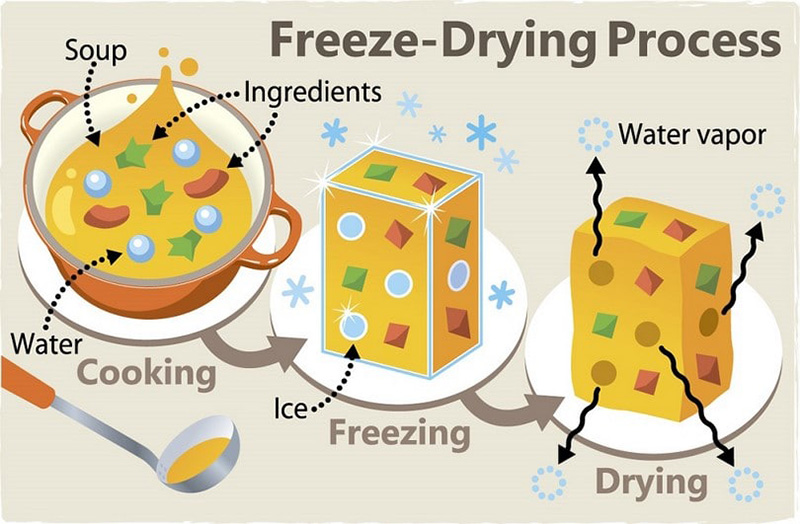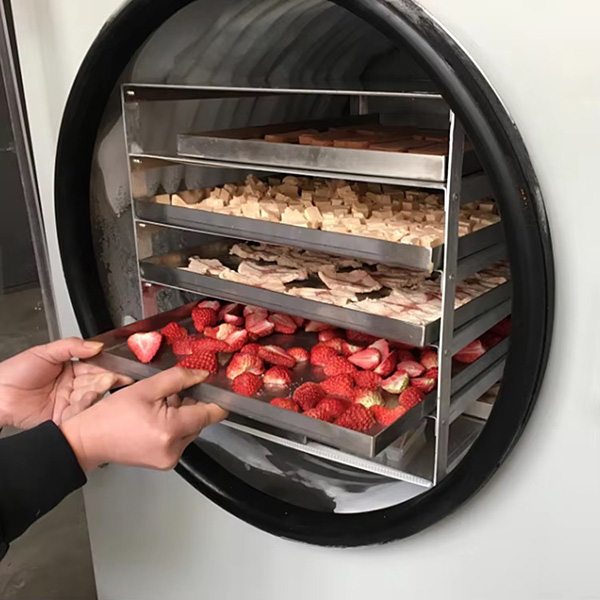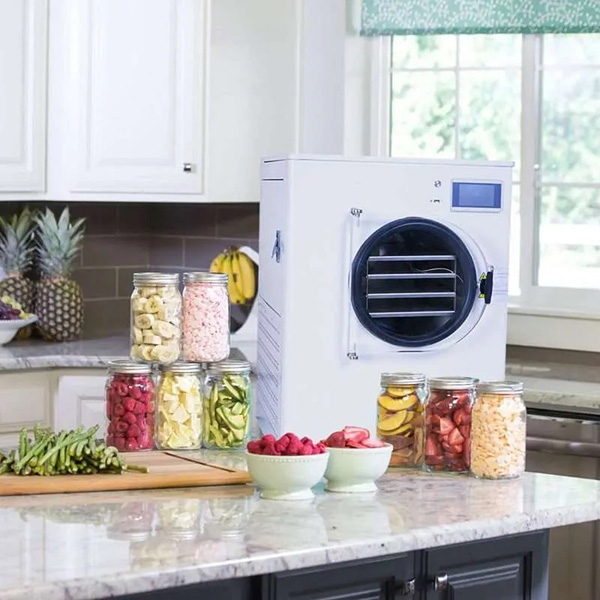
Content Menu
● Introduction to Food Dehydration
● Understanding Dry Machines for Food
>> Types of Dry Machines for Food
● Benefits of Using a Dry Machine for Food
>> Nutritional Benefits
>> Economic Advantages
● How to Choose the Right Dry Machine for Food
● Popular Foods to Dehydrate
>> Fruits
>> Vegetables
>> Herbs and Spices
>> Meats
● Steps to Use a Dry Machine for Food
● Tips for Successful Food Dehydration
● Creative Uses for Dehydrated Foods
● Maintenance and Care of Your Dry Machine for Food
● Comparing Dry Machines for Food with Other Preservation Methods
>> Dehydration vs. Freezing
>> Dehydration vs. Canning
● Environmental Impact of Using a Dry Machine for Food
● Future Trends in Dry Machines for Food
● Conclusion
● FAQs about Dry Machines for Food
>> 1. Q: How long does it take to dehydrate food?
>> 2. Q: Can I dehydrate different foods at the same time?
>> 3. Q: How long do dehydrated foods last?
>> 4. Q: Is it safe to dehydrate meat?
>> 5. Q: Can I use a dry machine for food to make pet treats?
Introduction to Food Dehydration
Food dehydration is an ancient preservation technique that has evolved with modern technology. Today, dry machines for food, also known as food dehydrators, have become increasingly popular among health-conscious individuals, culinary enthusiasts, and those looking to reduce food waste. These innovative appliances offer a convenient and efficient way to preserve a wide variety of foods while maintaining their nutritional value and enhancing their flavors.
Understanding Dry Machines for Food
A dry machine for food, or food dehydrator, is an appliance designed to remove moisture from various food items. This process extends the shelf life of foods, concentrates flavors, and creates unique textures. Modern food dehydrators typically consist of several key components:
1. Heating element
2. Fan for air circulation
3. Adjustable temperature controls
4. Multiple trays for food placement
5. Timer for precise drying
These machines work by circulating warm air around the food, gradually removing moisture without cooking the items. The result is perfectly dried food that retains most of its nutritional value and flavor.

Types of Dry Machines for Food
There are several types of dry machines for food available in the market:
1. Stackable Tray Dehydrators
2. Shelf Tray Dehydrators
3. Vertical Flow Dehydrators
4. Horizontal Flow Dehydrators
Each type has its advantages, and the choice often depends on the user's specific needs, budget, and available space.
Benefits of Using a Dry Machine for Food
Incorporating a dry machine for food into your kitchen routine offers numerous benefits:
1. Extended food shelf life
2. Preservation of nutrients
3. Space-saving food storage
4. Cost-effective food preservation
5. Reduction of food waste
6. Creation of healthy snacks
7. Versatility in food preparation
Nutritional Benefits
Dehydrating food using a dry machine preserves most of the nutritional content of fresh produce. Unlike other preservation methods that may involve high heat or chemical additives, food dehydration maintains the majority of vitamins, minerals, and enzymes present in fresh foods.
Economic Advantages
By using a dry machine for food, you can take advantage of seasonal produce when it's at its peak freshness and lowest price. Dehydrating allows you to stock up on your favorite fruits, vegetables, and herbs, ensuring a year-round supply of nutritious foods without the high costs associated with out-of-season produce.

How to Choose the Right Dry Machine for Food
When selecting a dry machine for food, consider the following factors:
1. Capacity: Determine how much food you plan to dehydrate at once.
2. Size: Consider the available space in your kitchen.
3. Temperature Range: Look for models with adjustable temperature controls.
4. Noise Level: Some machines can be noisy, so check user reviews.
5. Energy Efficiency: Look for Energy Star certified models.
6. Additional Features: Some dehydrators come with extra features like timers or automatic shut-off.
Popular Foods to Dehydrate
A dry machine for food can be used to dehydrate a wide variety of foods:
Fruits
- Apples
- Bananas
- Strawberries
- Mangoes
- Pineapples
Vegetables
- Tomatoes
- Carrots
- Peppers
- Onions
- Mushrooms
Herbs and Spices
- Basil
- Oregano
- Parsley
- Rosemary
- Thyme
Meats
- Beef jerky
- Turkey jerky
- Salmon jerky
Steps to Use a Dry Machine for Food
Using a dry machine for food is a straightforward process:
1. Clean and prepare the food items.
2. Slice the food into uniform pieces for even drying.
3. Arrange the food on the dehydrator trays, ensuring proper air circulation.
4. Set the temperature according to the food type.
5. Set the timer based on the food and desired dryness.
6. Start the dehydrator and periodically check the progress.
7. Once done, allow the food to cool before storing.
Tips for Successful Food Dehydration
To get the best results from your dry machine for food, consider these tips:
1. Choose high-quality, ripe produce for the best flavor.
2. Cut foods into uniform sizes for even drying.
3. Pretreat fruits prone to browning with lemon juice or ascorbic acid.
4. Blanch vegetables before dehydrating to preserve color and nutrients.
5. Rotate trays during the drying process for even dehydration.
6. Store dried foods in airtight containers in a cool, dark place.
Creative Uses for Dehydrated Foods
Dehydrated foods can be used in various creative ways:
1. Make your own trail mix with dried fruits and nuts.
2. Create homemade spice blends with dehydrated herbs.
3. Add dried vegetables to soups and stews for intense flavor.
4. Make fruit leathers for healthy, portable snacks.
5. Create your own tea blends with dried fruits and herbs.
Maintenance and Care of Your Dry Machine for Food
Proper maintenance of your dry machine for food ensures its longevity and optimal performance:
1. Clean the trays and interior after each use.
2. Check and clean the air filters regularly.
3. Inspect the fan and heating element for any signs of wear.
4. Store the machine in a clean, dry place when not in use.
5. Follow the manufacturer's instructions for deep cleaning and maintenance.
Comparing Dry Machines for Food with Other Preservation Methods
While dry machines for food offer many benefits, it's worth comparing them to other preservation methods:
Dehydration vs. Freezing
- Dehydration takes up less storage space.
- Frozen foods may retain more nutrients but have a shorter shelf life.
- Dehydrated foods are more portable and don't require refrigeration.
Dehydration vs. Canning
- Canning requires more equipment and can be more time-consuming.
- Dehydrated foods are lighter and more compact.
- Canned foods may retain more moisture and have a different texture.
Environmental Impact of Using a Dry Machine for Food
Using a dry machine for food can have positive environmental impacts:
1. Reduces food waste by preserving seasonal produce.
2. Decreases the need for energy-intensive refrigeration.
3. Minimizes packaging waste associated with store-bought dried foods.
4. Encourages local food consumption and reduces transportation emissions.
Future Trends in Dry Machines for Food
The technology behind dry machines for food continues to evolve:
1. Smart dehydrators with mobile app integration.
2. More energy-efficient models.
3. Combination appliances that can dehydrate, air fry, and perform other functions.
4. Improved materials for better heat distribution and faster drying times.
Conclusion
Dry machines for food offer a versatile, efficient, and healthy way to preserve a wide variety of foods. By understanding how to choose and use these appliances effectively, you can enjoy the benefits of dehydrated foods year-round. Whether you're a health enthusiast, a culinary explorer, or simply looking to reduce food waste, a food dehydrator can be a valuable addition to your kitchen arsenal.

FAQs about Dry Machines for Food
1. Q: How long does it take to dehydrate food?
A: Drying times vary depending on the food type, thickness, and desired dryness. Fruits can take 6-12 hours, vegetables 4-8 hours, and meats 4-12 hours.
2. Q: Can I dehydrate different foods at the same time?
A: Yes, but it's best to group foods with similar drying times and temperatures. Strong-smelling foods should be dried separately.
3. Q: How long do dehydrated foods last?
A: Properly dried and stored foods can last from 6 months to a year. Some items, like dried herbs, can last even longer.
4. Q: Is it safe to dehydrate meat?
A: Yes, but it's crucial to follow food safety guidelines. Meats should be heated to 165°F (74°C) before dehydrating to kill any bacteria.
5. Q: Can I use a dry machine for food to make pet treats?
A: Absolutely! Many pet owners use food dehydrators to make healthy, preservative-free treats for their pets.











